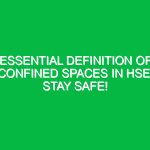Welcome to Today’s Toolbox Talk
Hello team! Today, we’re gathering for a crucial Toolbox Talk centered on a question that each of us should be asking every day: What Can Hurt Me Today? As we prepare to start our work, it’s vital to recognize that our Environment can present various risks and Hazards. By understanding these risks, we can take proactive steps to ensure our Safety and the Safety of those around us. Let’s dive into this topic to enhance our health, safety, and environmental (HSE) awareness.
The Importance of Asking “What Can Hurt Me Today?”
Every day on the job presents its own unique challenges and Hazards. By asking ourselves, What Can Hurt Me Today?, we create a culture of safety that encourages us to be vigilant and proactive. This mindset helps us to:
- Identify potential hazards: Recognizing risks before they become real threats.
- Encourage communication: Fostering an environment where employees feel comfortable discussing safety concerns.
- Promote accountability: Every team member taking responsibility for their own safety and the safety of others.
Recognizing Common Hazards
To effectively address What Can Hurt Me Today?, we must first identify common hazards that we may encounter in our daily operations. Here are some prevalent types of hazards:
- Physical Hazards: These include slips, trips, and falls, which are often caused by wet floors, uneven surfaces, or cluttered walkways.
- Chemical Hazards: Exposure to harmful substances, including solvents, paints, or cleaning agents, can lead to serious health issues.
- Biological Hazards: These encompass exposure to bacteria, viruses, or other infectious materials that can pose health risks.
- Ergonomic Hazards: Poor workstation design or improper lifting techniques can lead to musculoskeletal injuries.
- Psychosocial Hazards: Workplace stress or harassment can affect mental health and overall job satisfaction.
Assessing Risks in Your Work Area
Now that we’ve identified different types of hazards, it’s essential to assess the risks in your specific work area. Here’s how you can do that:
- Conduct a Walkthrough: Take a moment to walk through your workspace and identify any potential hazards.
- Ask Questions: Don’t hesitate to ask your colleagues what they think could pose a risk. Two heads are better than one!
- Utilize Safety Checklists: Many companies provide checklists for specific tasks or areas. Use these to guide your assessment.
Real-Life Example: The Importance of Awareness
Let me share a story that emphasizes the importance of asking What Can Hurt Me Today?. Last year, at one of our job sites, a worker failed to notice a spill on the floor. Rushing to meet a deadline, they slipped and fell, resulting in a significant injury. This incident could have been avoided if the worker had taken a moment to assess their surroundings and recognize the hazard.
This example highlights that safety isn’t just about following rules; it’s about being aware of your environment and making safety a priority. Always remember that your well-being is more important than any deadline.
Best Practices for Staying Safe
To minimize risks and promote safety, consider implementing these Best Practices into your daily routine:
- Use Personal Protective Equipment (PPE): Always wear the appropriate PPE for your task, whether it’s hard hats, gloves, safety glasses, or ear protection.
- Maintain Clean Workspaces: Keep your work area organized and free from clutter to reduce the risk of trips and falls.
- Report Hazards Immediately: If you see something unsafe, report it to your supervisor right away. Don’t assume someone else will take care of it.
- Take Breaks: Fatigue can lead to accidents. Remember to take regular breaks to stay alert and refreshed.
Engaging in Safety Discussions
Asking What Can Hurt Me Today? also opens the floor for discussions about safety in our workplace. I encourage you all to share your thoughts. Here are some questions to consider:
- What hazards have you encountered recently?
- What steps did you take to address these hazards?
- How can we improve our safety practices as a team?
Feel free to share your experiences, as they can help others learn and stay safe.
Regulations and Standards to Keep in Mind
Compliance with safety Regulations and standards is non-negotiable. Understanding these regulations can help us maintain a safe working environment. Here are some key regulations to be aware of:
- Occupational Safety and Health Administration (OSHA) Standards: osha sets forth regulations that employers must adhere to in order to ensure Workplace Safety.
- Environmental Protection Agency (EPA) Guidelines: These guidelines focus on minimizing environmental impact and ensuring safe chemical handling.
- Company Policies: Familiarize yourself with our organization’s specific safety policies and Procedures.
Knowing these regulations not only helps protect you but also ensures compliance with legal obligations that can affect our organization.
Conclusion: Taking Safety Seriously
As we conclude today’s Toolbox Talk, I want to emphasize the importance of asking What Can Hurt Me Today?. By being proactive and aware of our surroundings, we can significantly reduce the risk of accidents and injuries. Remember, safety is everyone’s responsibility, and it starts with you.
Thank you for your commitment to safety and your participation in today’s discussion. Let’s carry this mindset into our workday and look out for one another. Together, we can create a safer workplace for everyone.


